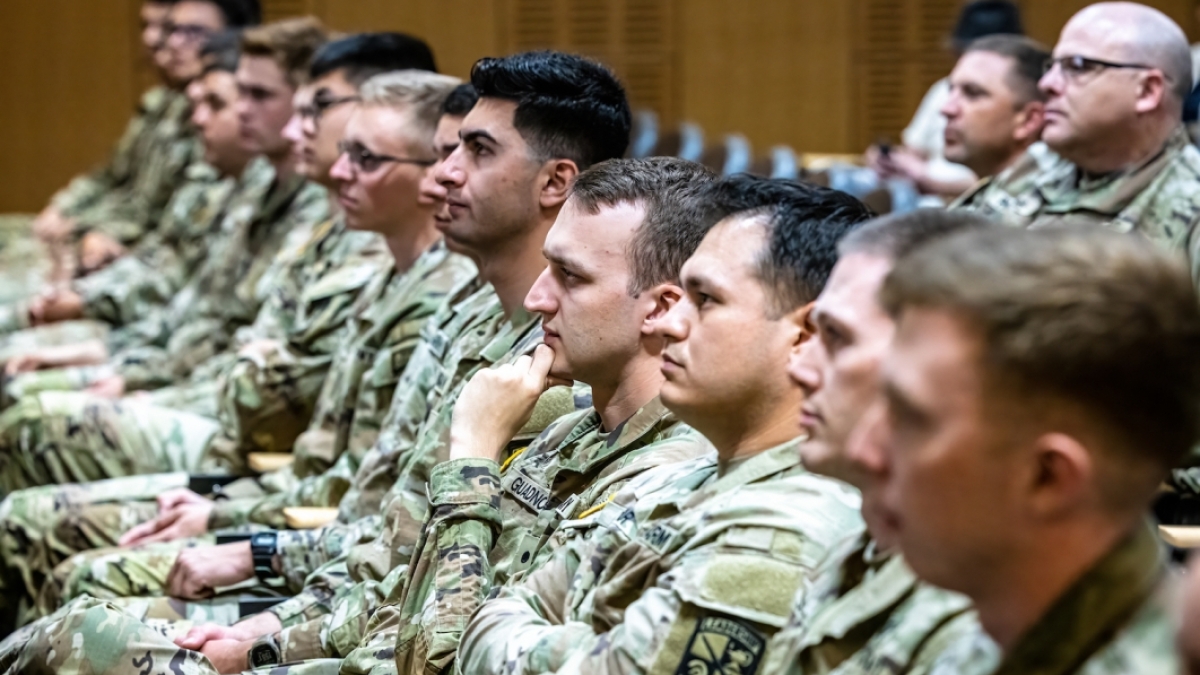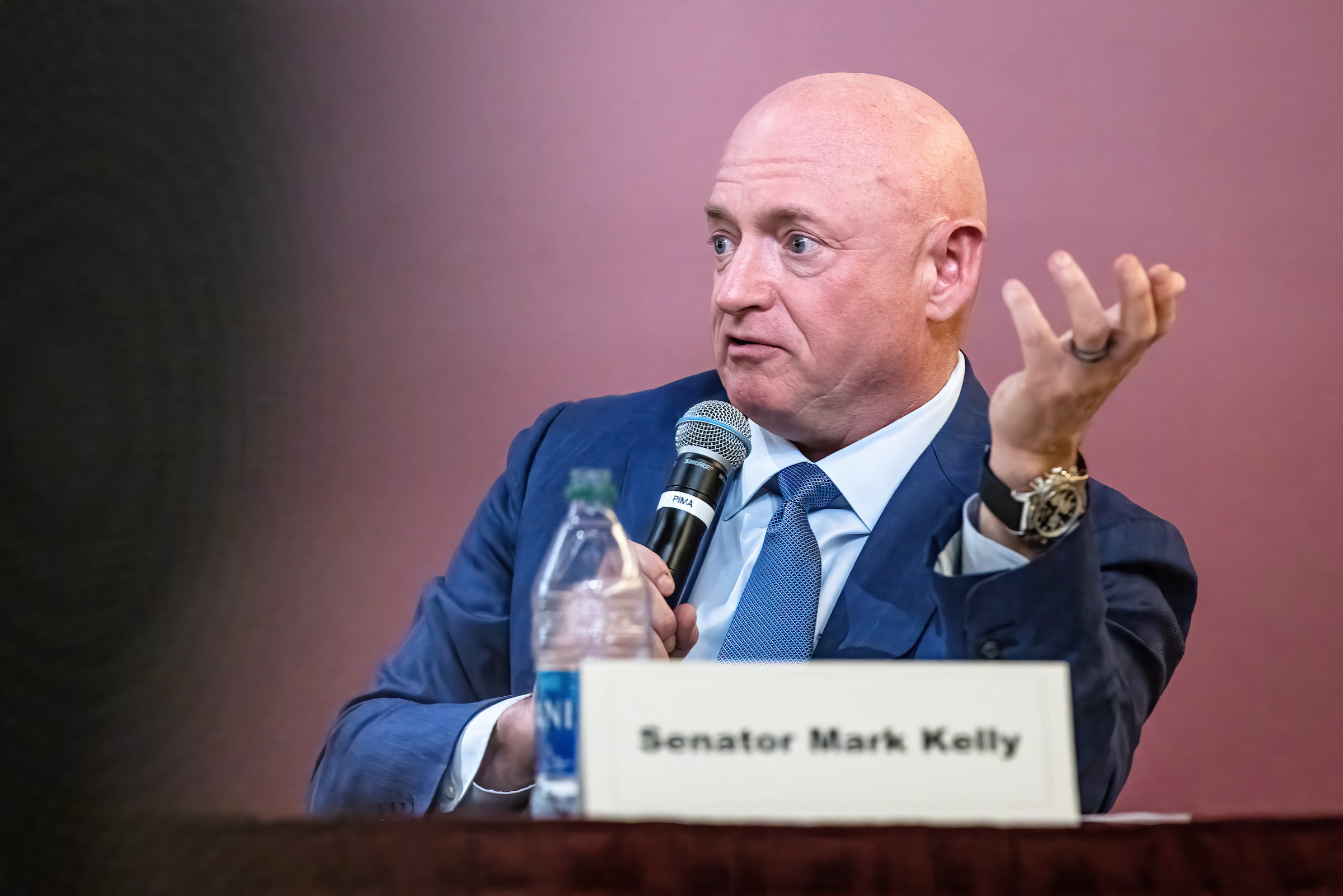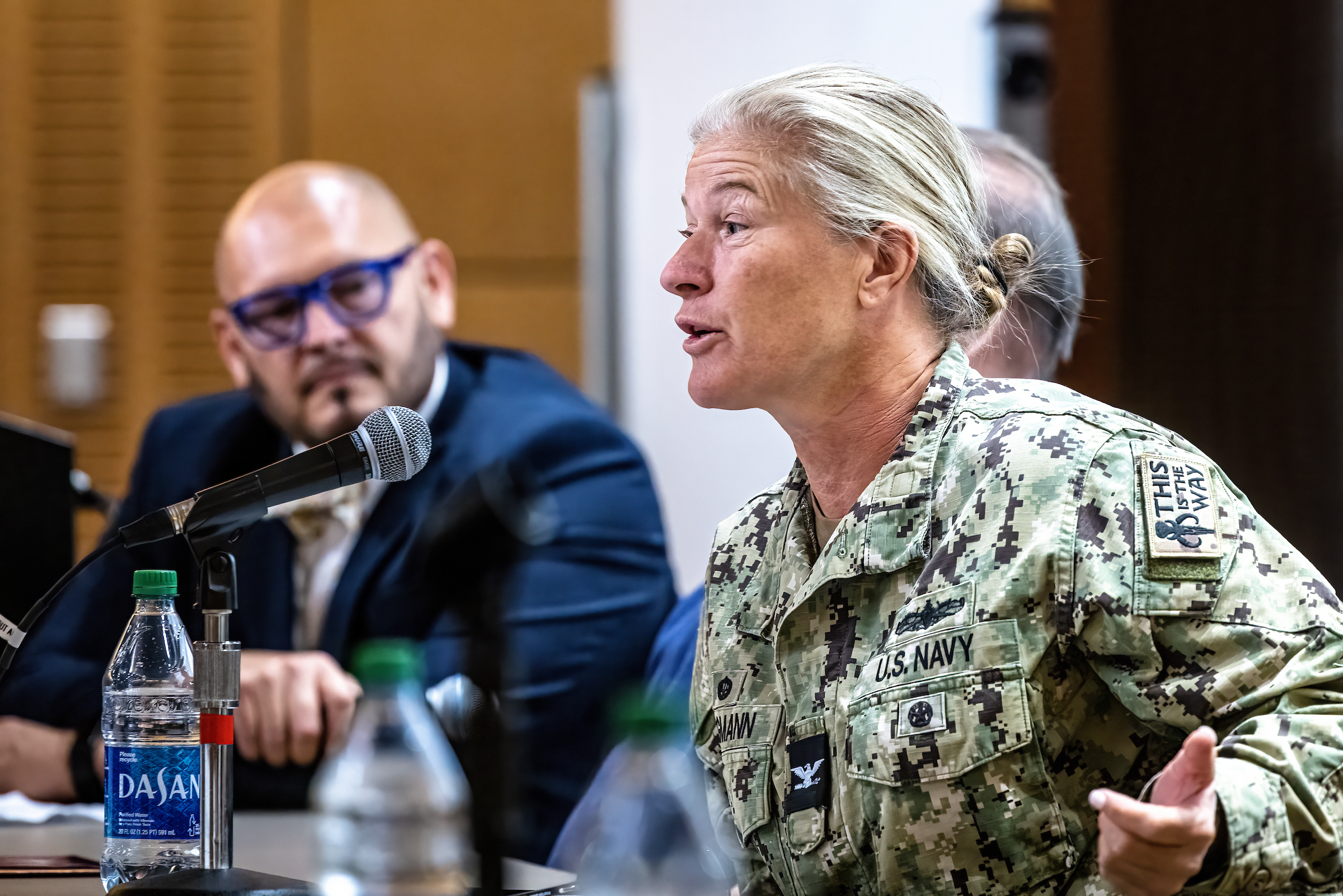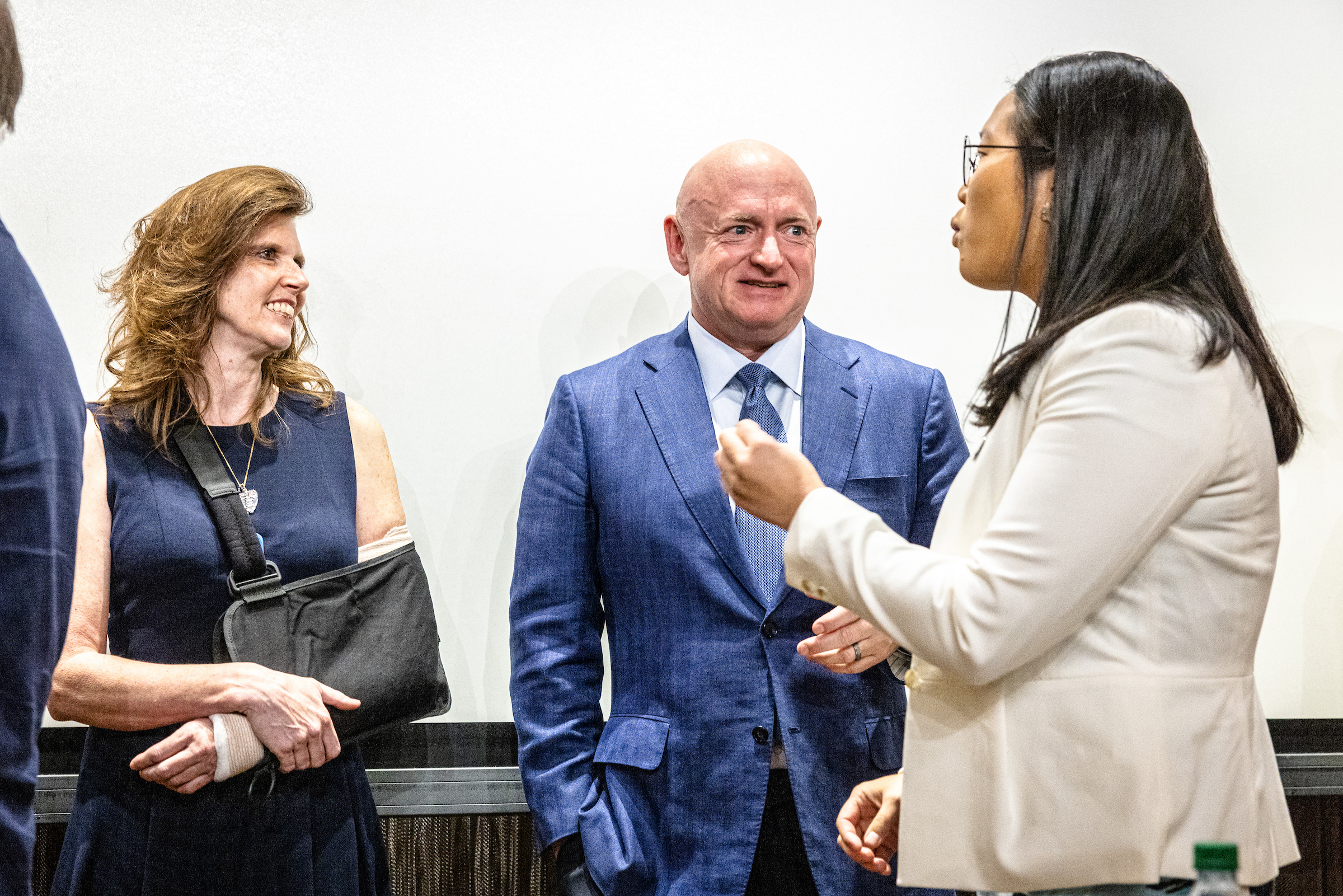Active-duty military personnel in crisis need real help, not an obstacle course, when it comes to accessing mental health counseling.
That’s the basis of the Brandon Act, a recently passed piece of legislation introduced by U.S. Sen. Mark Kelly of Arizona in honor of fallen U.S. Navy Petty Officer 3rd Class Brandon Caserta of Peoria, Arizona.
“The fact of the matter is there’s still a stigma about mental health that exists in our society, but specifically in the military,” said Kelly, a Gulf War veteran and aviator who served 25 years in the Navy. “We need to figure out a way to outgrow that. This is a good first step in doing that.”
Kelly’s comment was made at an April 12 panel discussion titled "Combating Military Suicide: How the Brandon Act Will Prioritize Mental Health Care in the Military." The event was hosted by Arizona State University’s Pat Tillman Veterans Center at the Memorial Union on the Tempe campus.
Sen. Mark Kelly asks a question of one of the panelists at the "Combating Military Suicide" event on April 12. Photo by Charlie Leight/ASU News
The goal of the discussion was to bring together local military leaders to have a dialogue about mental health and spark positive change, said Jeff Guimarin, executive director of the Tillman Center.
“There’s a direct connection between those serving on active duty, in the National Guard or in the Reserves with veterans. They carry the weight of their service into civilian life, and it is often a tremendous burden,” Guimarin said. “I believe that if we make it easier to access help while serving, it will create a positive continuum of support as they become veterans. We need to eliminate the roller coaster ride and give service members stability. That’s why we want to bring this issue to the forefront here at ASU, in Arizona and across the country.”
In addition to Kelly, the panel also included Patrick Caserta, father of Brandon Caserta and a Navy veteran; Capt. Ande Bergmann, ASU Naval ROTC; Lt. Col. Erich B. Schneider, ASU Army ROTC; Maj. Fernando Garcia, 492nd Civil Affairs Battalion; and Sgt. HyeJung Park, an ASU doctoral student, Tillman Scholar and an Army reservist. Shawn Banzhaf from the Tillman Center, who is an Army veteran, handled moderating duties.
Before the panel spoke, Guimarin introduced Teri Caserta, Brandon’s mother, to give an overview of his life and death, which came as a result of suicide.
“Brandon was our only child. He was funny, kind, very generous,” she said. “He always lived by his karate code words — honor, respect, patience and kindness.”
She said Brandon joined the military in 2015 and tested to become a Navy SEAL. She said during training, he collapsed and passed out on the beach during one of their exercises. An instructor “rang a bell” for Brandon, which signified he was quitting. It was a move Brandon argued against but had no choice. Shortly afterward, he was reclassified as an aviator electrician and sent to Norfolk, Virginia.
Teri said the first day Brandon arrived in Norfolk, he was labeled a "BUD/S Dud" — slang for Navy SEAL dropout.
From there, it was all downhill.
“He was bullied, harassed and retaliated against,” Teri said. “Many times they told him to suck it up and that he was fine. They refused to give him any kind of mental health assistance.”
On June 25, 2018, Teri said he walked out onto the flight line, stepped up to the person in charge and apologized for what he was about to witness.
“He then ran into the spinning rear tail of the helicopter,” Teri said.
The Casertas said their son’s death opened their eyes to the “suicide epidemic” in the active-duty and veteran community. According to the Department of Veteran Affairs, roughly 20 U.S. veterans kill themselves a day. And since 2006, there has been an 86% increase in the suicide rate among 18- to 34-year-old male veterans.
In drafting the Brandon Act, which was signed into law in December by President Joe Biden, the Casertas hope to protect current service members who experience mental health emergencies and reduce the stigma around reporting. This bill allows service members to seek mental health treatment and requires a mental health evaluation as soon as a service member self-reports. It will also permit Americans serving in uniform to seek help confidentially and, if necessary, outside of the chain of command.
“Our son’s story needs to be heard and used to save lives,” said Patrick Caserta, who formed the Brandon Caserta Foundation with his wife, which provides assistance, guidance, education and resources to active-duty service members, veterans and their families. “We will continue to work with the Congress to address issues that need to be fixed so that the military can become a safer, better place to serve.”
Other panelists agreed.
Schneider said the Army has several mandatory training requirements on soldiers, which includes suicide prevention, but questioned its efficacy.
“Yes, you could argue the Army was doing something about suicide prevention, but was it effective?” he asked. “Absolutely not. There’s no question that we’ve got a problem. And it’s a growing problem. The Army and senior leaders recognize that there’s a problem.”
Capt. Ande Bergmann, commanding officer of the Naval ROTC unit at the ASU, speaks on her experience with sailors experiencing mental stress. Photo by Charlie Leight/ASU News
Bergmann, who served as commanding officer of the destroyer USS Howard, said sailors face unique challenges that can chip away at their mental health and must be vigilant because they’re out at sea and away from their families for long periods of time. She added sometimes all they need is to hear a friendly voice from home to get them through a rough spot.
“One of the nicest things about technology is that when there’s someone in need, they can pick up a phone and call home,” Bergmann said. “I had that capability in my state room. I 100% used it. If you needed to call home, I let you call home.”
Garcia said reservists also face distinctive stressors because they have many balls in the air and not much time.
“They (reservists) must maintain a family life, a civilian career and a military career all at once,” he said. “Despite what commercials say about two days a month and two weeks a year, that’s not an experience anyone actually has.”
Garcia said that he has discovered by sharing some of his vulnerabilities with his soldiers, it helps him to become more human to them.
“It communicates to my soldiers, ‘I can trust this person. I can go to this person because he is telling me about his own challenges,’” he said. “I hope that helps remove the stigma for them and that potentially makes them more willing to share any issues they may be having. I feel broadly that it’s incumbent upon leaders in the military to do more of the same to expose your own vulnerability.”
Park noted that military service is not unlike the college experience, which can be a stressful period.
“Military members during their first enlistment are about 18–25, and they’re about the same demographic,” said Park, who is studying developmental psychology. “They also have the same challenges that college students experience. They just left home. They’re youthful and ambitious. And sometimes when things go awry and their goals aren’t met, instead of being supplied with resources, they have to be able to pivot and have a new goal.”
Park said a cultural shift needs to take place in the military in order for soldiers to get the help they need.
“It’s OK to go out and seek mental health for yourself. Sometimes you have to be selfish,” she said. “A lot of times it’s difficult to ask for that help, but it’s a pathway that’s readily available and clear.”
Guimarin closed out the discussion by addressing a group of about two dozen ROTC students in attendance.
“You will all be taking on leadership roles when you commission, so please consider the perspectives and wisdom you heard today and use it to shape your leadership approach and philosophy,” he said. “That should inspire you to keep watch over your people and offer them all the tools and resources they need to be healthy and successful. Make it a point to lead by example and show them there’s no stigma associated with seeking help.”
Sen. Mark Kelly chats with Teri Caserta (left) and doctoral psychology student and Army Reserve Sgt. HyeJung Park following the "Combating Military Suicide" event. Photo by Charlie Leight/ASU News
Top photo: Several ASU ROTC cadets listen to Sen. Mark Kelly speak at "Combating Military Suicide: How the Brandon Act Will Prioritize Mental Health Care in the Military," on Tuesday, April 12, at the ASU Memorial Union in Tempe. Photo by Charlie Leight/ASU News
More Law, journalism and politics
Can elections results be counted quickly yet reliably?
Election results that are released as quickly as the public demands but are reliable enough to earn wide acceptance may not always be possible.At least that's what a bipartisan panel of elections…
Spring break trip to Hawaiʻi provides insight into Indigenous law
A group of Arizona State University law students spent a week in Hawaiʻi for spring break. And while they did take in some of the sites, sounds and tastes of the tropical destination, the trip…

LA journalists and officials gather to connect and salute fire coverage
Recognition of Los Angeles-area media coverage of the region’s January wildfires was the primary message as hundreds gathered at ASU California Center Broadway for an annual convening of journalists…





